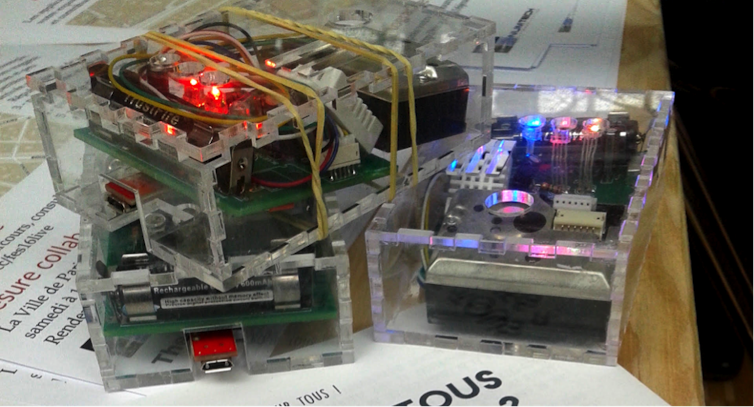
What’s Your Exposure to Air Pollution?
By Laurence Eymard, Laure Turcati and Sébastien Payan at Sorbonne University
Estimating individual exposure to urban air pollution remains a real challenge, particularly due to technical limitations. But for some time now, new human-centered approaches have been renewing the way we approach the issue.
Let's start by recalling an obvious fact: air pollution kills. The WHO indicates that seven million deaths are due to air pollution every year worldwide, mainly from respiratory and cardiovascular diseases. Is the air we breathe toxic? The answer is yes.
City dwellers are the most exposed to this risk of mortality, linked to the high concentrations that gaseous and particulate pollutants can reach. Indeed, urban populations suffer not only from pollution from local emission sources (mainly urban transport and heating), but also from diffuse pollution carried by air currents over long distances (industrial emissions, pesticides, pollens, various aerosols).
In France, several cities regularly exceed regulatory thresholds. The French government has been condemned on several occasions for "insufficient action" by the Court of Justice of the European Union (CJEU), and a trial is underway in London on the role of pollution in the death of a child. However, we are far from starting from scratch.
From reference stations to micro-sensors
Since the 1970s, an extensive air quality monitoring and forecasting network has been gradually deployed throughout the country. It is based on a network of so-called "reference" stations and is managed at the regional level by approved air quality monitoring associations.
The measuring points are few in number, but the instruments are located in carefully selected areas and the sensors in operation are rigorously calibrated. The monitoring associations also use numerical and statistical models to estimate the distribution of the main pollutants in the given region.
However, if the street on which you live does not have a measuring station, which is likely to be the case, the estimate provided is in fact only the statistical average for the neighbourhood, which is itself based on an inventory of fixed sources and average hourly traffic, taking into account the weather conditions of the day, especially wind.
In other words, if you try to find out your personal exposure to air pollution from the national monitoring system, you will at best only get an average value for a given pollutant. This makes it difficult to derive reliable information about your personal exposure to "air pollution", let alone the health risk it poses to you.
However, in recent years, "micro-sensors" have been introduced on the market that hold the promise of accurate and reliable measurement of personal exposure to air pollution. Could these small, portable measuring instruments, available at the price of a smartphone, change the situation?
Limitations in design, measurement and use
A sensor consists of a detection system for one or more pollutants, for example a laser diode whose beam is attenuated or scattered by the passage of polluting particles; an electronic system to record the signal; a microcomputer to interpret it (for example, convert the attenuation of the light beam during a given time into the number of particles). It often also collects time, position, temperature and humidity.

Micro sensors built in fab labs or manufactured by companies are complex instruments.
In the case of reference stations, the measurement of a pollutant is a complex process that requires numerous upstream qualification tests as well as costly maintenance. To guarantee the reliability of the data generated, the sensor must comply with specific conditions of use and must be stationary for the duration of the measurement in particular. Finally, in order to compare data from several sensors, the measurement conditions must be similar: height above ground, air inlet into the sensors and integration time of primary measurements, among others.
Individual micro-sensors meet different specifications: they use lower quality detectors, they are not calibrated regularly and they provide information that is often integrated for at least one minute to achieve acceptable accuracy. Their use can vary: the sensor may be moving or hung differently each day, for example.
Even more problematic, for a given model, each sensor behaves differently and there is not yet a unique calibration strategy. In addition, all instruments are subject to the phenomenon of "measurement drift", which can occur at different times for each sensor. In the case of micro-sensors, it would appear from our studies that the drift occurs much faster than for approved instruments for various reasons, including the robustness of the detection principles, the miniaturization of the detection components, the protection against environmental disturbances (temperature, humidity).
Finally, the use of these micro-sensors by people not trained in their use introduces an additional source of error: incorrect handling, for example a sensor in a pocket or masked by a scarf.
When acquiring a micro-sensor for personal use, it is therefore important to bear in mind that one is using an instrument that does not de facto meet the same quality standards as reference stations.
Limits to the exploitation of measurements
To enable reliable monitoring of one's own exposure, it is necessary to control the quality of the sensor data. The most common approach is to ask the wearers of mobile sensors to periodically go near a fixed measuring station or to systematically compare the measurements of the different sensors when they are close to each other, in order to carry out inter-calibration.
Another difficulty comes from the fact that the detection of an extreme exposure peak by the mobile sensor is often difficult to characterize: Is it the toast that burned in the toaster? Is it the truck at a standstill with the engine running for 10 minutes? By being aware of these contextual elements and documenting them in the form of metadata, it is possible to eliminate false positives a posteriori, but this implies increased attention and additional work at the time of collection. Data processing is therefore a challenge in itself. This can be addressed in part through a rigorous protocol, but it requires awareness among micro-sensor users.
Involving individuals in estimating their exposure
If, as has been pointed out, most of the difficulties encountered are of a technical nature, the solutions to these same problems could well be based in part on a refocusing of the systems on the human factor, in particular through "citizen sciences" or "participatory sciences".
Training users in the use of their instrument and involving them in the co-construction of knowledge in fact offers three positive aspects: this type of approach represents both a societal interest (citizen involvement, development of scientific culture), an industrial interest (user feedback, testing of instruments in a scientific context), and of course a scientific interest, because it increases the volume and representativeness of data and secures data quality: the data generated becomes more usable and more useful for everyone.
This article was co-written by Jérémy Hornung, from PartiCitEnv's association (formerly PartiCitaE).
Laurence Eymard, CNRS Emeritus Research Director, researcher in the field of climate, Sorbonne University; Laure Turcati, Research Engineer in participatory sciences, Sorbonne University and Sébastien Payan, Professor, Sorbonne University.
This article has been republished and translated from The Conversation under a Creative Commons license. Read the original article (in French.)
